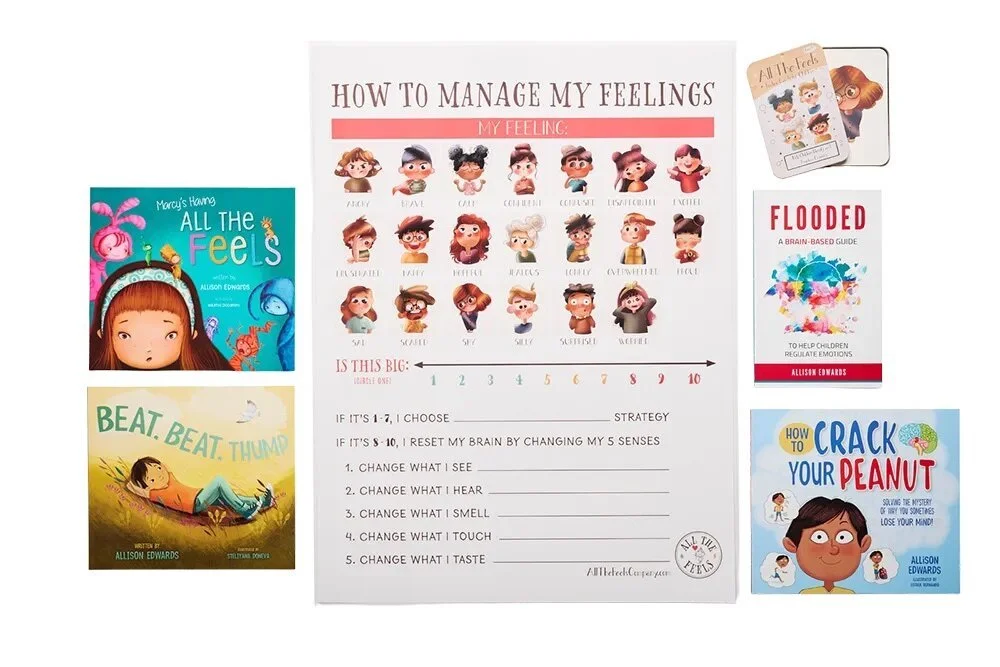All The Feels: ADHD, Anxiety, & Risk-Taking With Allison Edwards
As a parent, you want what's best for your child, but sometimes their behavior can leave you feeling frustrated and helpless. On top of normal parenting woes, kid’s diagnoses of ADHD and anxiety are going up while kid’s engaging in healthy risk-taking and resilience seem to be plummeting.
So, I reached out to a child psychotherapist, Allison Edwards, to get to the bottom of this.
Allison Edwards is a child psychotherapist, author, speaker, and the founder of All the Feels Company. With a graduate degree in Counseling from Vanderbilt University and a National Certified Counselor, Licensed Professional Counselor, and Registered Play Therapist certification, she has amassed over 20 years of experience as a school teacher, counselor, psychotherapist, and educational consultant. Allison has authored six books, including Why Smart Kids Worry, Flooded: A Brain-Based Guide to Help Children Regulate Emotions, and How to Crack Your Peanut.
Allison is an expert in supporting children's emotional development, particularly in empowering them, recognizing the needs of gifted students, and helping anxious children. She provides consultation and staff development to improve emotion regulation in classrooms and assists parents in navigating the social and emotional differences between home and school environments.
5 Questions With Allison Edwards From All The Feels
1. What are some common mistakes parents make when it comes to managing their child's behavior?
Common mistakes parents make are:
They aren't in control of their own emotions. Kids will push your buttons and most of the mistakes/regrets we have as parents come from the decisions we make when emotionally flooded.
Looking beneath the behavior to the emotion. Oftentimes, anxiety looks like defiance. If you can see the anxiety beneath the, "I'm not going to soccer practice," you can support your child in the anxiety instead of giving a consequence for not going.
2. Can you explain the four steps of emotional regulation and provide some practical tips for parents to implement them with their child?
Step 1: Identify the feeling
Step 2: Rate the Intensity (1-10)
Step 3: Name the Trigger (what caused the emotion)
Step 4: Choose a Strategy (coping, emotion regulation strategy)
A great way to implement the steps is to make it a bedtime routine. Ask your child to pick three feelings about their day and then you pick 3 as well. Parents should always pick the feeling their child struggles with the most and choose it every day. This models that parents also struggle with emotions. Then go through the steps together. The child will pick the feeling they feel the most and then move through the steps of rating the intensity, naming the trigger and choosing a strategy.
Kids pick this up very fast and the goal is they will be able to do this on their own.
3. There's growing evidence that kids are becoming increasingly anxious. Why is this?
Kids are more anxious because 1. the world is scarier than it used to be and 2. today's kids no longer know how to manage discomfort.
Anxiety is fear of the future and most kids will get out of future things because parents or schools let them out. When kids aren't able to do hard things, they become even more anxious. Thus, the cycle continues.
Most parents think they are helping their kid by letting them out of future events but in reality, they are making it worse.
4. For a child who displays ADHD tendencies, what emotional regulation techniques have you found to be effective and how can parents integrate them into their daily routine?
The best thing to do for an ADHD child is to help them release energy as soon as they wake up. Get a trampoline and ask your child to jump 100 times before having breakfast. Have them run sprints in the yard, play basketball before school, etc.
Kids with ADHD wake up with a full tank and the goal should be to drain the tank to 1/2 before they get to school. This will help the day go much smoother.
Also, keep them off screens as much as possible. The hyperfocus element of ADHD makes it really hard to get off screens so most conflicts come from this struggle.
5. How can parents encourage their child to engage in healthy risk-taking behaviors that foster resilience?
Risk taking is very important in childhood. Taking risks builds confidence and allows kids to see what they are capable of. Only doing things you know you're good at reinforces that you have to be good at everything, which keeps many kids from trying new things. I refer to it as building emotional muscles. As with any exercise routine, building muscles is not going to be comfortable at first, but the stronger you become, the easier tasks become. Doing hard things and taking risks helps grow emotional muscles so kids can develop the strength to do hard things.
Examples of risk taking for children are:
Choosing to do a sport you've never done before
Taking a class that seems interesting
Wading through a creek for the first time
Touching an animal that you've read about in a book (i.e. snake being held by zookeeper, etc.)
Applying to a college you have a low chance of getting into
Entering your poem into a contest, etc.
Kids love to accomplish new things and every new thing is risky. Over time, kids will have the emotional strength to on more and more risks which will build confidence and self-esteem.
To find out more about Allison and her work, go to allthefeelscompany.com. She also has an Emotional Regulation Toolkit and here is a link to my Emotion Regulation Toolkit (picture below) which uses the strategies above.




